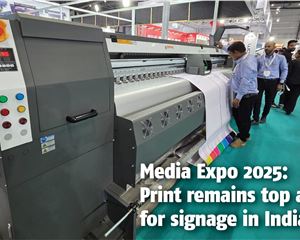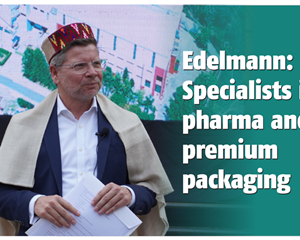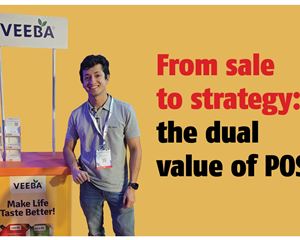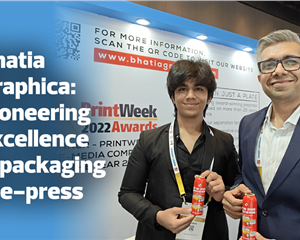Product of the Month: Oce ColorWave 700
Product of the Month: Oce ColorWave 700
08 Apr 2016 | By Rushikesh Aravkar
With the growing pressure on the wide-format industry from activists and government agencies to adopt a safe and healthy working environment, wide-format players are exploring alternative to solvent inkjet.
Oce ColorWave 700 from Canon’s stable perfectly fits the bill for low production costs, substrate flexibility and low odour prints.
Canon’s Bibhuti Kumar Narayan, manager – solutions marketing, says the latest ColorWave 700 is a workhorse, which allows printers to expand their portfolio of wide-format offerings and at the same time helps customer to get rid of investing in multiple equipment to cater the large
range of applications.
What he implies is that, commercial print firms can use it to consolidate their wide-format plan and map printing along with graphical applications onto one system, which can replace multiple colour inkjet printing systems and improve efficiency.
After unveiling the ColorWave 700 in February 2015, the company is pitching it at businesses requiring a higher print volume, including reprographics, sign and display printers and in-house printing applications in industries such as retail, hospitality, POS, education and government.
Hybrid imaging
Now, the differentiating factor for Canon’s Colorwave 700 is its imaging technology. It’s not inkjet and it’s also not toner. It’s a hybrid one, which, according to the manufacturer, combines the positives of the two while doing away with their negatives. They like to call it CrystalPoint technology and the ink TonerPearls.
The TonerPearls are held as solid balls, which by the virtue of their physical properties are safer and easier to handle than either liquid ink or finely divided powder toner. Inside the system, these solid balls are melted into gel, which is then imaged onto the substrate. As it cools, it crystallises onto the substrate.
Due to the toner’s gel state, droplets stay compact even when jetted onto highly absorbent media. The crystallisation process forms a strong adhesion with an even semigloss finish. “This offers strong adhesion to a variety of media and makes the ink suitable for outdoor or heavy-duty
use,” says Narayan.
“In use, there are no solvents and no ozone produced, meaning there doesn’t need to be any extraction and the finished prints are odourless and water-resistant.”
According to Narayan, the major difference between thermal inkjet heads and Oce’s imaging device is that the later is not reliant on any type of plumbing system since there are no liquids used in the system.
“Because the TonerPearls are heat activated, they simply return to a solid state when the machine is powered off. In theory, you could turn on and use the printer even if it has
been off for a year or longer.”
The first machine to use this technology was Oce’s ColorWave 600 launched in 2008. In 2012, it was deployed for ColorWave 550/650. “And now it has been reworked in terms of features and technology for ColorWave 500 and 700 in 2015.”
All the machines build on CrystalPoint technology have an inbuilt system to calculate the ink consumed during printing and provides meter reading in TAC (Total Area Coverage) format to the user.
“The users is charged as per the TAC reading. In TG service model Canon takes care of complete maintenance of machine including consumables and spares,” says Narayan.
How fast?
The ColorWave 700 is the fastest machine in the series. In the high-speed mode, the ColorWave 700 produces monochrome prints at the speed of 1,389 sq/ft per hour and colour prints at 1,292 sq/ft per hour. This roll-to-roll wide-format printer can print up to 1,800 A1 CAD drawings or 640 high-quality posters per eight-hour working day.
It can also print on low-cost uncoated media or high-end specialties. The machine is powered by Oce MediaSense technology that supports media thickness of up to 800 μm or 30 mil, in standard and custom sizes. “It measures the media thickness and adjusts the printing distance to the media automatically. The system extends the application range even more.”
Among other features, the machine boasts of cloud integration, automatic media sensing, multiple user support, secure workflow and an optional built-in scanner.“Up to six different rolls of media can be loaded at one time meaning that each printer can simultaneously handle a number of different jobs without having to load and unload rolls in between,” adds Narayan.
When asked about the alternatives of ColorWave 700 in the market, Narayan, says, “Customer has to choose multiple machines like inkjet, LED, toner etc to cater the application supported by Oce ColorWave 700.”
| SPECIFICATIONS |
|---|
|
Speed B&W 225 A1/hr
Colour 212 A1/hr
Resolution 600dpi
Roll options 4-6 rolls
Width 297 to 1067mm
Max thickness 800μm; 30mil
Contact Canon India, Bibhuti Kumar Narayan, bibhuti.narayancanon.co.in
|
| THE ALTERNATIVES | |
|
HP Pagewide XL 5000
The HP PageWide XL 5000 Printer series includes a stationary
40-inch (101.6-cm) printbar that spans the whole printing
width. As paper moves under the printbar, the entire page is
printed in one pass, enabling very high printing speeds.
|
|
| Maximum print speed 9 m/min (27.8 ft/min) | |
| Roll width 279 to 1016 mm | |
| Media weight 70 to 200 g/m² | |
|
Contact: Devang Karia HP
devang.karia@hp.com
|












 See All
See All